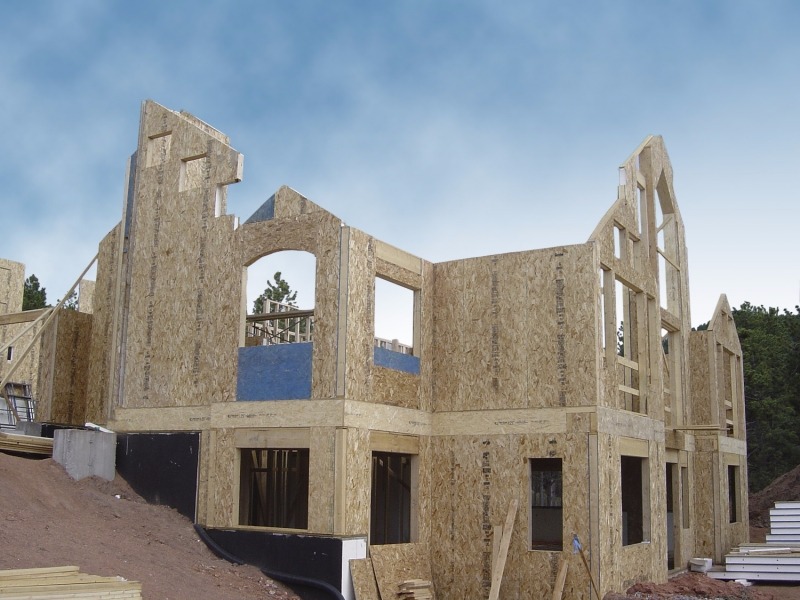The construction and operation of buildings has a significant impact on the environment. Buildings account for 39% of total U.S. energy consumption and 38% of carbon dioxide emissions. Sustainable buildings use less energy, reducing carbon dioxide emissions and play an important role in combating global climate change. Buildings also use a tremendous amount of natural resources to construct and operate. Constructing sustainable buildings that use these resources more efficiently, while minimizing pollution, is crucial to a sustainable future. Structural insulated panels (SIPs) are one of the most air-tight and well-insulated building systems available, making them an inherently green product. An airtight SIP building will use less energy to heat and cool, allow for better control over indoor environmental conditions, and reduce construction waste.
SIPs Save Energy
Building with SIPs creates a superior building envelope with high thermal resistance and minimal air infiltration.• Oak Ridge National Laboratory(ORNL) Whole-wall R-value studies show that a 4-inch SIP wall (nominal) rated at R-14 outperforms a 2×6 stick framed wall with R-19 fiberglass insulation.
- ORNL blower door tests reveal that a SIP test room is 15 times more airtight than its stick framed counterpart with fiberglass insulation.
- Up to 40% of a home’s heat loss is due to air leakage.
- SIPs have demonstrated amazingly low blower door test results when properly sealed. Based on the reliable performance of SIPs, ENERGY STAR chose to eliminate the required blower door test for SIP homes to meet ENERGY STAR standards.
SIPs Save Resources
The major components of SIPs, foam and oriented strand board (OSB), take less energy and raw materials to produce than other structural building systems. SIPs are also fabricated in a controlled environment, allowing for greater efficiency than site-built framing. The NAHB estimates that the construction of a 2000 sq. ft. home produces 7,000 lbs. of waste. SIPs have the ability to drastically reduce the waste generated during construction by using advanced optimization software and automated fabrication technology to ensure the most efficient use of material.
- OSB is manufactured from fast-growing, underutilized, and often less expensive wood species grown in carefully managed forests. The OSB production process uses small wood chips and highly automated machinery, making OSB a very efficient use of raw materials.
- About 85-90% of a log can be used to make high-quality structural panels, and the remainder – bark, saw trim, and sawdust – can be converted into energy, pulp chips or bark dust.
- EPS is a lightweight insulation composed mostly of air. Only 2% of EPS is plastic. Over the lifetime of a house, the EPS insulation used in SIPs will save many times the energy embodied in the petroleum used to make EPS (see Life Cycle Analysis for more info).
- It takes 24% less energy to produce EPS than fiberglass insulation of equivalent R-value.
- Scrap EPS generated during the manufacturing process can be recycled into new EPS products.
Indoor Air Quality
A SIP home or commercial building allows for better control over indoor air quality because the airtight building envelope limits incoming air to controlled ventilation. Controlled ventilation filters out contaminants and allergens, and also allows for incoming air to be dehumidified, reducing the possibility for mold growth. There are a variety of ventilation strategies that can be employed to provide fresh air to airtight homes. These vary by climate, but most are relatively inexpensive and operate on automatic control systems without the need for homeowner action. SIPs do not contain any VOCs or other harmful chemicals that can affect occupant health. The components used to make SIPs (foam, oriented strand board, and adhesive) meet some of the most stringent standards for indoor air quality.
- EPS uses pentane, a non-CFC blowing agent that dissipates shortly after production. EPS has no off-gassing and many EPS manufacturers are GREENGUARD certified
- SIP homes have qualified under the American Lung Association’s Health House® indoor air quality standard
- The adhesives used in SIP production do not contain any measurable amounts of volatile organic compounds (VOCs) that can be harmful to occupants
- Oriented strand board (OSB) does not contain urea formaldehyde adhesives and meets the world’s leading formaldehyde emissions standards, including the U.S. HUD Manufactured Housing Standard, the California Air Resources Board (CARB) Air Toxic Control Measure for Composite Wood Products and the European EN-300 Standard
Learn more about OSB and formaldehyde
Learn more about expanded polystyrene (EPS) and HBCD flame retardants


